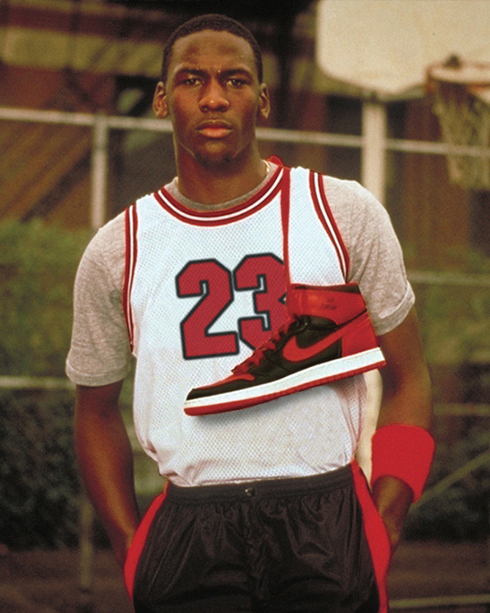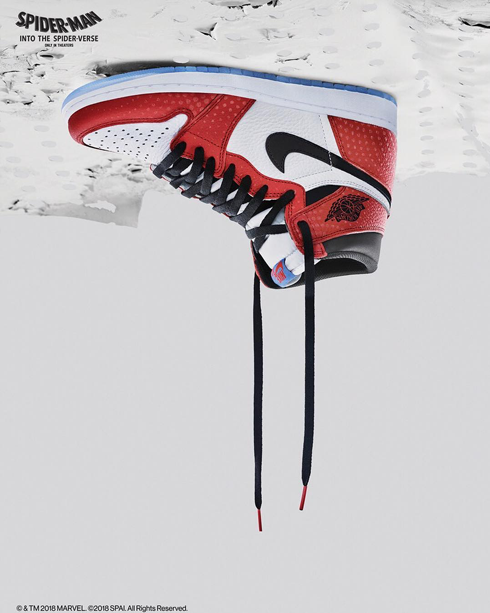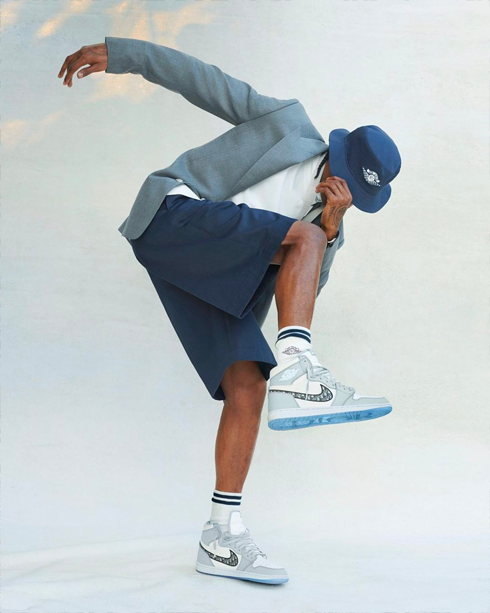Jordan
11
Jordan’s daring comeback sneaker.

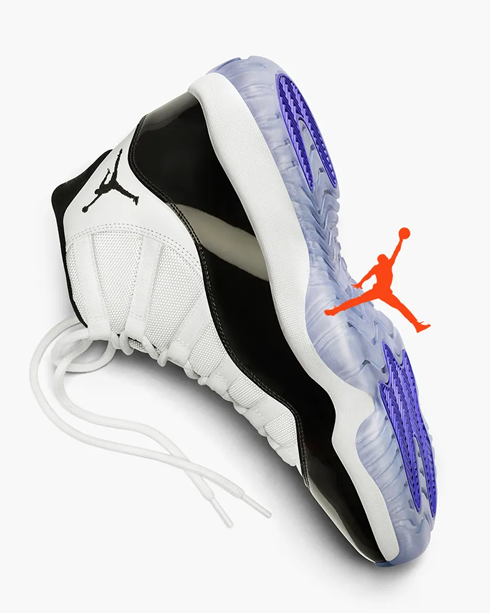
A shock announcement
By the early 1990s, Jordan Brand was well-established, and its iconic line of basketball trainers was powering towards its first double-digit release. Then, in 1993, just months before the launch of the Air Jordan 9, the shoe’s legendary namesake, Michael Jordan, announced that he would be retiring from pro basketball. Many at Nike and Jordan Brand were shaken by this, some even suggesting that the line should be wound up with its tenth instalment, due in 1994. However, one man remained unfazed – renowned designer and Jordan stalwart Tinker Hatfield. He began work on a new model that would carry the sneaker’s legacy into the future. More than that, though, his shoe would come to symbolise Michael’s return to the sport, all while distinguishing itself as one of the most highly prized of all sneakers – the irrepressible Jordan 11.
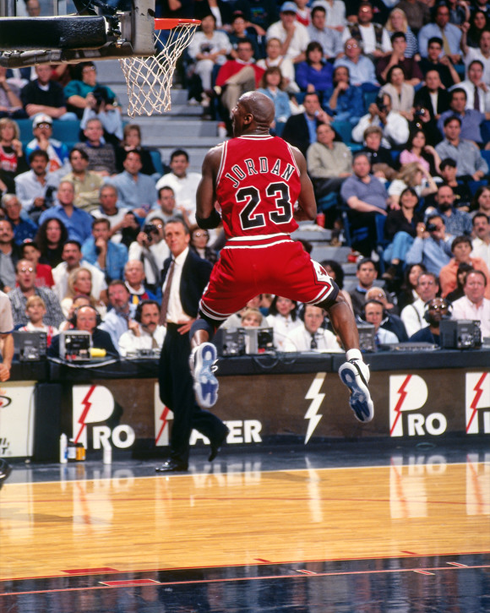
An important meeting
A number of the brand’s experts worked alongside Tinker to produce the Air Jordan 11, including Ken Black, who was both a graphic designer on the project and its art director. In late 1993, he, Tinker and Nike executive Howard “H” White got together with Michael Jordan to discuss their plans for the new sneaker. The basketball player was used to the process by now, having worked with Hatfield and other designers on many signature shoes, and the group met in the casual setting of his Arizona condo. They knew that he would be completely honest with them at this point, even if it meant rejecting their ideas, and they presented him with drawings and materials that demonstrated the proposed concepts rather than a finished design. It was important to get Jordan’s approval on the general fit and feel of the AJ11, particularly the textiles they planned to use, which ranged from soft nylon to textured mesh to shiny patent leather. Jordan’s main stipulation was that the shoe be styled in such a way that it could be worn with a tuxedo – a look he was keen to be seen in at the time. His request came to define the Air Jordan 11 as Hatfield’s response was to produce a bold and daring basketball trainer with high-performance features and a suave, elegant appearance that would look great when paired with formal attire.
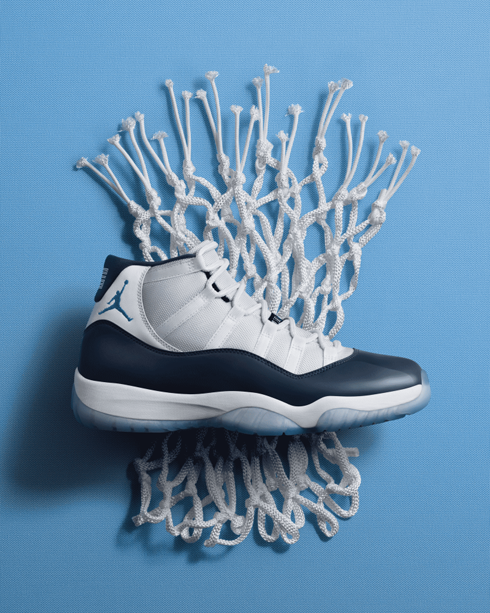
Fulfilling a dream
As the team worked to create the shoe through the first months of 1994, Jordan made another shock announcement – he was to become a baseball player in honour of his late father, who had always dreamed his son would play the sport. Wearing a cleated version of the Jordan 9, he played for Minor League Baseball team the Birmingham Barons before moving to the Scottsdale Scorpions for the second part of the year. Though not ideal for the Jordan line, which, after all, was known for producing top-quality basketball shoes, it belied the remarkable comeback that was to occur just a few months later. This incredible turnaround was to revive both the player and his signature sneaker, in the process vindicating the hard work, thought and innovation Hatfield had put into the construction of the Jordan 11.
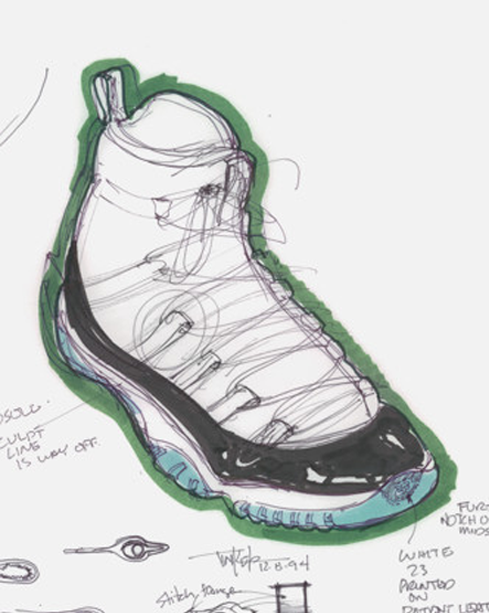
“I’m back”
On 18th March, 1995, Michael Jordan announced his return to the NBA with a simple statement: “I’m back”. He rejoined the Chicago Bulls in time to wear the Air Jordan 10 for the final part of the regular season, but, as the Bulls qualified for the playoffs, he had a new shoe to try out, one which had never been seen before – one which would change the landscape of sneaker culture forever.
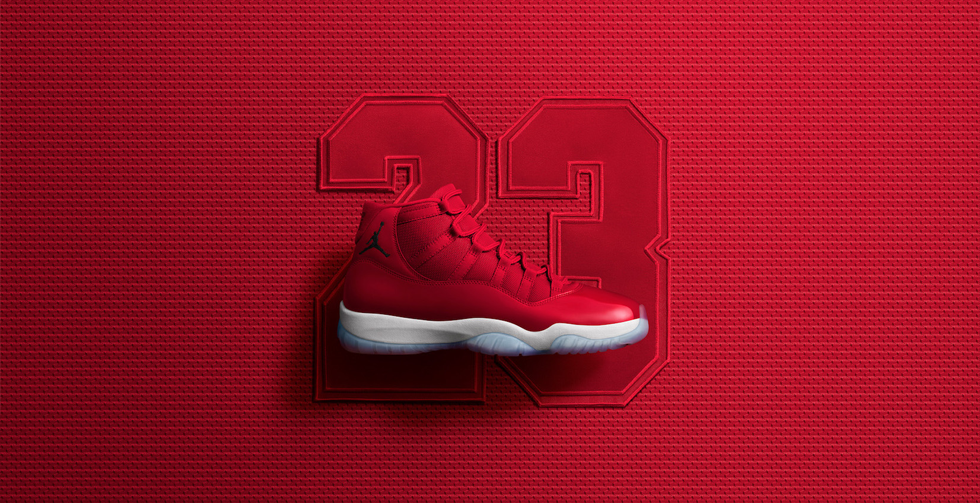
A shoe that couldn’t wait
Jordan had been given a pair of his new signature shoe in the Spring of 1995, months prior to its expected release date. This was standard practice, and he was used to getting each new design early but not being allowed to wear it in public. However, on receiving the Air Jordan 11, he was so enamoured with it that he couldn’t resist donning it at the earliest opportunity. On May 7th, 1995, the sneaker made its debut appearance on the court during Game 1 of the Eastern Conference semifinals between the Chicago Bulls and Orlando Magic. Its strikingly unconventional look caught the eye of those watching, in particular its glossy patent leather mudguard, whose shiny black surface wrapped around the entire circumference of the shoe. Below it was a white Phylon foam midsole filled with Air cushioning that ran the length of the foot. Hatfield had been keen to build a shoe that, while exuding sophistication and style, was still filled with high-performance technology that could stand up to the rigours of the basketball court. As such, he placed a carbon fibre plate between the midsole and outsole. Having already discovered the power of revealing a shoe’s technological components on the Air Max 1 over a decade earlier, Hatfield made the outsole of the AJ11 partially see-through to show the use of this lightweight, supportive shank. Segments of Dark Concord purple, for which the Concord colourway was named, were placed beneath the forefoot and heel, herringbone grip lines bringing the sneaker quality traction as well. Completing the design was a white ballistic nylon mesh on the upper, with more white leather around the heel.
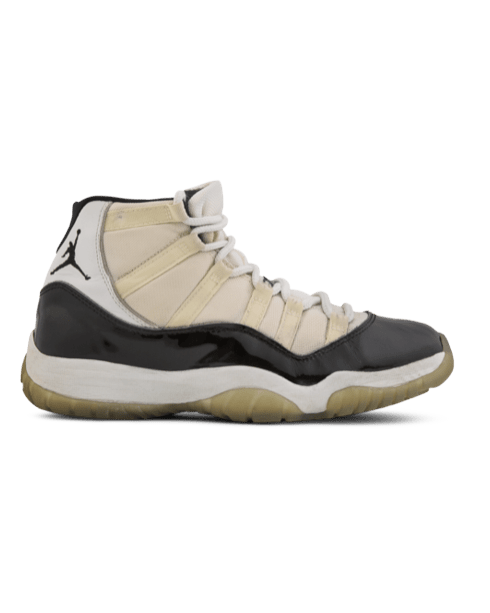
Sophisticated inspirations
The combination of materials used on the Air Jordan 11 meant that it was lighter, more durable and more responsive than its predecessors, while its elegant black and white outer made it the ideal complement to a formal outfit, as Jordan had desired. In fact, Hatfield had been so keen to fulfil Jordan’s wish that he looked to luxury fashion brands like Armani and Prada when designing the shoe’s clean branding effects. These consisted of a band of black fabric with Jumpman and Jordan text in white over the top of the white mesh tongue, Jordan’s baseball jersey number of 45 on the back of the foot, which he had taken to wearing on his return to basketball, and a black Jumpman logo on the lateral heel. By the time of its general release at the end of 1995, he had reverted to wearing his traditional 23, and the shoe was changed accordingly, the number 45 only to be seen on a few retro models in the decades that followed.
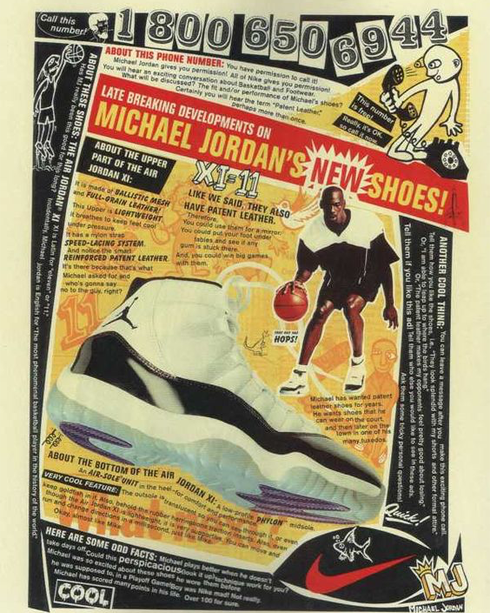
A rebellious throwback
As the Eastern Conference semifinals progressed, the incredible story of the Jordan 11 deepened. In Game 2, Michael came alive, leading the Bulls with 38 points as they fought back to level the series. During a lull in play when Jordan was sat on the bench, the camera focussed in on his trainers, prompting the commentators to question whether they were “black and white or white and black” – an innocuous statement that referred to the NBA’s playoff rules, which forbid the shoe for its predominantly white outer. The rest of the Bull’s players wore black shoes with red highlights, in keeping with the team’s colours, and Jordan was fined for the first two games, evoking memories of the controversial Banned AJ1 colourway that began the sneaker line in 1985.
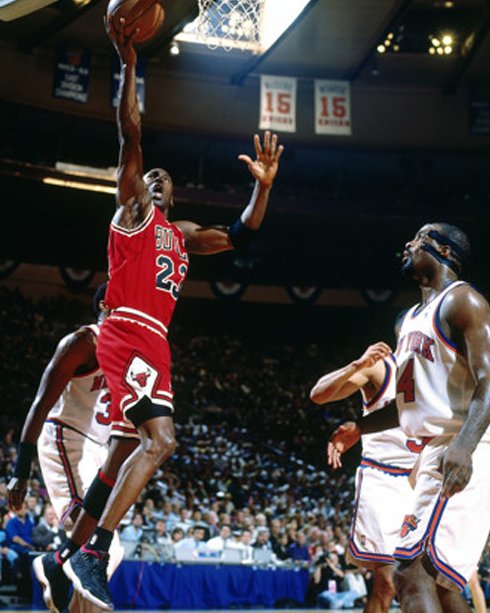
Media attention
Jordan returned in Game 3 wearing a modified pair of Penny Hardaway’s Nike Air Flight One before switching to a different Air Jordan 11 colourway for the remainder of the semifinals. It had an all-black upper that was more acceptable to the league’s administrators and drew fresh comments, this time from courtside reporter Ahmad Rashad. As the camera zoomed in on Jordan’s black AJ11s, he mentioned the patent leather – featured on a basketball shoe for the first time in history – and the use of his baseball jersey number of 45 on the heel. He then joked that he would be taking the player’s old shoes home as the camera panned down to reveal that he was wearing the Concord colourway Jordan had sported during the first two games of the series.
The 100ft dunk
Unfortunately, the Chicago Bulls ended up losing the playoffs 4-2, but the immense hype created around Jordan’s new signature shoe laid the foundations for its eventual success. Part of this was down to his return to form as he scored the most individual points in four of the six games. Jordan Brand built on this through its memorable 100ft dunk commercial in which Michael was shown charging towards an exceptionally high basketball hoop before leaping to score a massive slam dunk. He was left hanging from the hoop as the camera switched to his viewpoint looking down on the shoe disappearing towards the floor, his Air Jordan 11 Concords clearly visible on his feet.
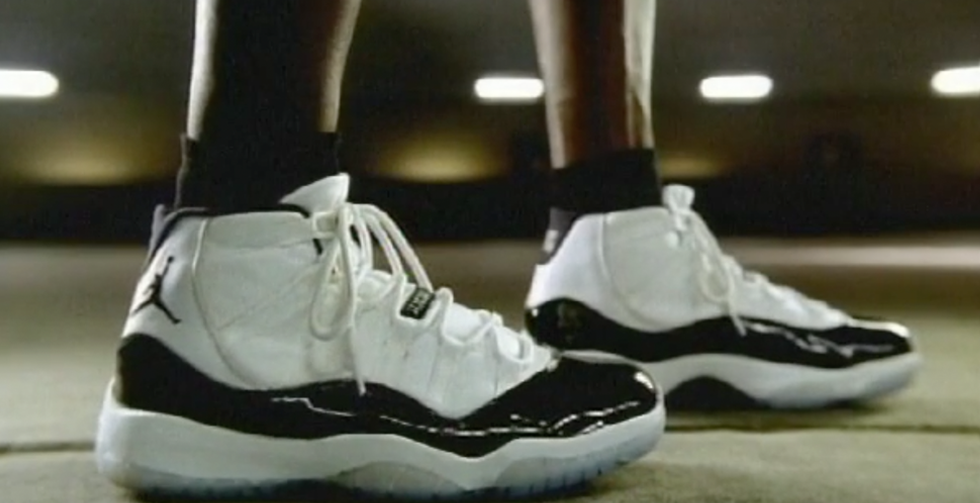
A new colourway
On its release at the end of 1995, the Jordan 11 was incredibly well-received. Its look was radically different to other basketball shoes of the time, and its powerful use of technology made it an excellent performance trainer. As a result, it quickly became a popular choice amongst Jordan’s fellow players, as well as establishing itself as a must-have casual sneaker. Alongside the black and white Concord, new colourways soon followed. The first was a design known as the Columbia, which was mostly white with Columbia Blue highlights on the branding and sole. While Jordan favoured the Concord throughout the ‘95-’96 regular season, he wore this updated colourway while showing off his skills in the All-Star Game in February 1996.
The legendary Bred and another championship
Not long after this, a black and red model known simultaneously as the Playoffs and the Bred was released. Its colour scheme was a fan-favourite thanks to its appearance on one of the earliest Air Jordan 1 releases, and the Air Jordan 11 edition’s nod to this classic became equally desired. Shops were inundated with eager sneaker enthusiasts who couldn’t wait to get their hands on the famous colourway, and some stores sold out of the shoe in mere minutes. This was way before Jordan had even worn it, something he saved for that season’s playoffs, which began on April 26th. Jordan’s plan was for his whole team to turn up for the knockout games in black shoes and socks, giving them a formidable unity and making them laser focussed on the task at hand. Keen viewers could notice the red and white accents on his AJ11s, but otherwise, the powerful effect was achieved, and Jordan’s Bulls flattened their Miami Heat opposition, knocking them out of the competition in just three games. Jordan topped the score sheet in two of them and went on to be named Finals MVP as his team won the NBA Championship yet again. He wore the Breds throughout the playoffs, removing them for the last time after being pictured lying in tears on the locker room floor, clutching the match ball in his hands. This stunning image thrust the colourway into the limelight once more, and every subsequent Bred retro has been highly sought-after.
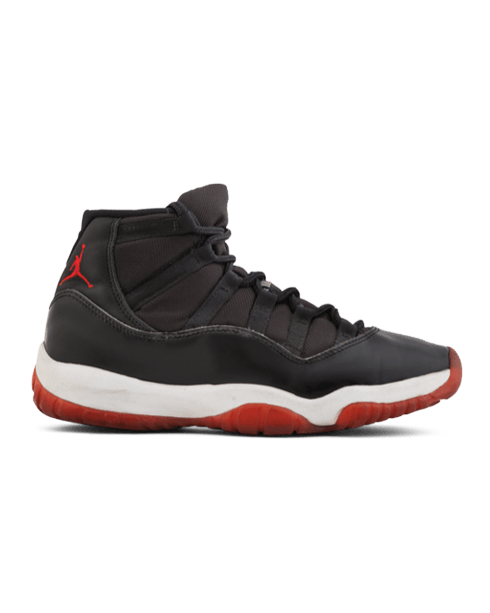
An extraordinary season
Jordan’s fourth NBA title capped off a record-breaking season for the Chicago Bulls. They finished the regular season 72-10 – a record that wouldn’t be broken for another two decades – before lifting the championship trophy after a successful playoff run that saw them lose just three games across four series, including a 4-0 thrashing of the Orlando Magic to avenge the previous year’s defeat. Jordan contributed so much to the team’s success during the campaign that he received a clean sweep of MVP awards, adding the All-Star Game and regular season awards to his Finals accolade. This incredible year solidified Jordan as the dominant force in the game once more, and the fact that he wore the Jordan 11 throughout the entire competition secured its place in sneaker history. No wonder Michael himself has since named it as his favourite amongst all his signature designs, though he did liken the decision to choosing his favourite child.
From strength to strength
Following the success of both Jordan the man and Jordan the shoe, both went on to achieve more and more great things. In 1996, the 11 was released as a low-top version known as the Air Jordan 11 Low IE. Coming in two different colourways, it reworked the look of the original, swapping out its trademark patent leather for a mix of elephant print leather and mesh. During the same year, the sneaker appeared on the big screen in the movie Space Jam. Michael wore the shoe as he teamed up with Bugs Bunny and his animated pals to take on a group of alien basketball players. The design was similar to the one he had worn in the second half of the ‘94-’95 playoffs, with a sleek black upper, white midsole and translucent blue outsole. Fans of the model would be disappointed initially since the Air Jordan 11 Space Jam didn’t go on general release when the film came out. Then, in 2000, retro versions of all three OG colourways began to emerge, and the Space Jam was released to the public for the first time.
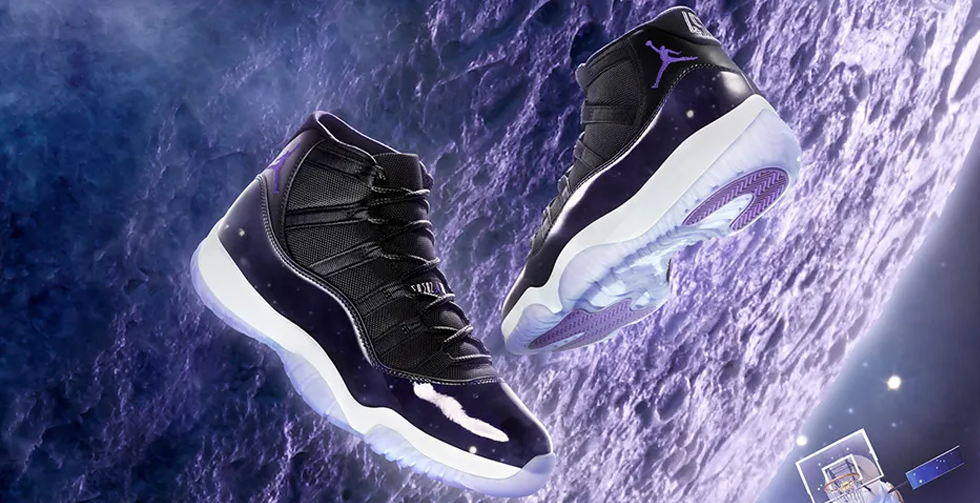
An ever-growing roster
This began a fertile period for the Air Jordan 11, and a string of new designs were released in the years that followed, including 2001’s Cool Grey colourway, which was worn by Jordan during his two-seasons with the Washington Wizards and is now considered a classic, the first women’s version and several low-tops that returned to the patent leather build of their high-top counterpart. Nowadays, many of the AJ11s that were released during this time are equally well-regarded, such as the 2006 sneaker that accompanied a Jordan 6 model in the Defining Moments Pack. Its design is similar to the Concord, but with golden details that reference the second of Jordan’s era-defining three-peats.
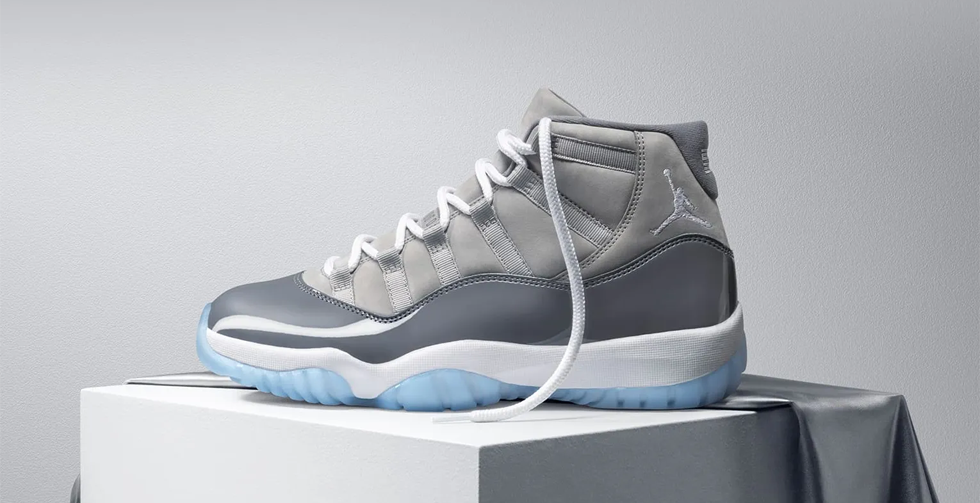
A holiday tradition
In December 2008, the Air Jordan 11 Bred was re-released as part of the Countdown Pack, before 2009 delivered the Space Jam once more, its popularity setting a precedent for future holiday releases which has lasted for over a decade since. Each year, fans wait with excitement to discover whether the December launch will be a retro of a classic model, a reworking of an earlier colourway or a completely new design. Notable examples include 2011’s faithful Concord retro, 2013’s Gamma Blue, whose pale blue highlights reference Jordan’s time at the University of North Carolina, 2014’s edition of the Columbia known as the Legend Blue, and 2022’s Cherry – a modern version of the Varsity Red from 2001. Alongside these designs, there have been commemorative ones, such as 2015’s 72-10, which was made to mark two decades since the beginning of that remarkable title-winning season of ‘95-’96, and 2020’s Jubilee, with its silver detailing honouring 25 years of the Jordan 11. The annual celebration of the AJ11 has seen the sneaker maintain and even grow its popularity over the years as Jordan Brand continues to bring back heritage colourways while also innovating on new models.
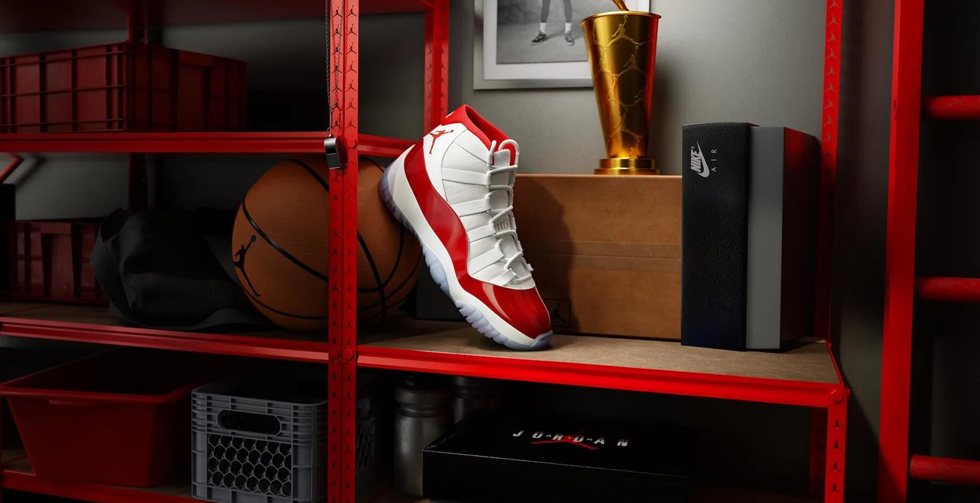
The shoe that tells a story
Although the Air Jordan 11’s incredible legacy was sealed way back in the mid-90s with Michael’s outstanding return to form and the Chicago Bulls’ unprecedented NBA season, its unique aesthetic and sophisticated styling have seen it become one of the most well-renowned sneakers in history. Michael Jordan and Tinker Hatfield have both showered the shoe with praise, the former for its performance capabilities and the fact that he could wear it with a tuxedo, the latter because of his daring design approach, which gave the model its technological edge and distinctive look. Today, the Jordan 11 is a beloved sneaker that stands for much more than fashion and style – it represents Jordan’s unbelievable comeback story and Hatfield’s exceptional creative talent, marking a moment in history that will live long in the memories of those who were there and be celebrated by new generations of sneaker enthusiasts for years to come.
